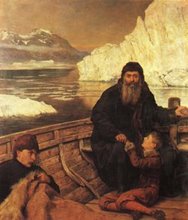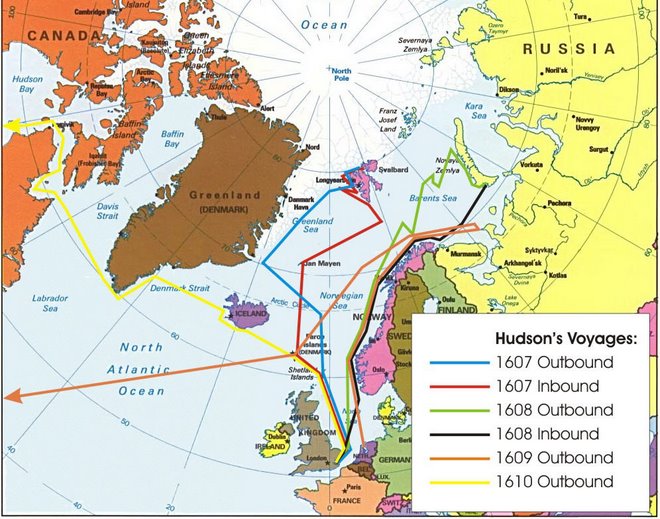Wednesday, May 23, 2007
My First Voyage
Tuesday, May 22, 2007
My second voyage
My second voyage was again financed by the English Muscovy Company. My goal was again to find a northeast route to the Orient. I again sailed with the same ship and crew. As before, strong winds and ice forced me to turn around and head back to
Half Moon
I sailed my many voyages on Half Moon ships. The original ship was called the Halve Maen, and it was commissioned on March 25, 1609 for the Dutch East India Company. The company hired me although I am an Englishman. They hired me to search for a passageway between the

The Switch To The Dutch
In the summer of 1609 the ship the Half Moon sailing under Captain Henry Hudson under the flag of the Dutch East India Company searched in vain for a western passage to the
My third Voyage
For the last two voyages I have had the same crew, but this time since no one in England want to sail from me so for this voyage I am sailing for Holland, and on a new ship called the Half Moon I am trying to find a north east rout to Asia. We reached what is now Nova Scotia, Canada first and traveled south to about where Virginia is, then after we went back north and sailed up and down the what is now called the Hudson river, and after I found the end to the river I went back because again supplies ran short and my crew was not happy so we went back to Holland only to try again on my fourth voyage.
My Fourth Voyage
In 1610, I had decided to try to find the Northwest passage to
Henry's Last Days

As the Discovery prepared for sailing, Hudson made the decision to divide the food that was left and give each a portion of the food. The plan was not the best he made, because some of the men ate their entire two-week allowance of food in a single day. Many of the crew members suspected Hudson of holding some for himself, while he suspected some of the men of hoarding all of the food. In a hunt of evidence of hoarding, Hudson sent the ship’s boy, Nicholas Syms, to search the crew’s sea chests. He found thirty or more “cakes” and brought them to Hudson. It was later revealed that Hudson did have favorites among the crew and did take better food as well as more food for himself and these special individuals. Hudson felt that “it was necessary that some of them should be kept up.” The crew then decided that because Henry was hoarding the food to mutiny. The mutiny that occurred was that Hudson along with his son was left in the now Hudson bay in a small wooden boat without food, water, clothes, or fire. They eventually froze and no one ever found a sign of them being there.
Saturday, May 19, 2007
Aftermath of Henry's Voyages and Exploring as a whole
During the 16th century, Europe underwent a time of exploration and curiosity for the world. Whilse the reasoning's of this cannot be totally known, it is safe to say that at this time there was a lot of controversy between most European countries. Merchandising was at a high point in society and because of this, different countries were found from merchandising, leading citizens to wonder what else was out there in the world. Causing geographers to question theories and maps. There was also a lot of controversy between religions. Travelers set their sails to find new lands for people to back them up. With the tail of their discoveries to new lands people became curious to what was around them in the world. Henry Hudson underwent most of his voyages in hope of finding passage ways to Russia and to the Orient. The first voyage he went on was to find passage through the north and then across the pole. On his second voyage he journeyed to find a northeast passage through Arctic waters north of Russia. The third voyage took him on search (by the Dutch that hired him) to find the same northeast passageway as before. On his fourth voyage he was seeking a northwest passage which happened to be one of the voyages he had most wanted to undergo since he started his first voyage. All of these deemed unsuccessful of what he was really looking for but he discovered many other things along the way.For Hudson's first two voyages, he was financed by the Muscovy Company which agreed with his point of the expedition. They financed the ship Hopewell for him. After struggles with getting along with his crew on the first two voyages, he was rejected to seek sponsors and crew from England which led to his turning to the Dutch. He was hired and financed by a Dutch company that had heard about his discoveries and offered him another chance. When he returned from this voyage he was believed to have been sponsored mainly by Sir Thomas Symthe who at that current time was the governor and treasurer of the Virginia Company, and also the English East India Company. Hudson's goals for his voyages consisted on finding passageways up north towards Russia and the Arctic. None of his voyages are known to have been fulfilled. Although at the time his discoveries were miniscule now they are very great.Voyages back in the 16th century were, as expected, a lot more dangerous than modern day explorations. Conditions were primitive, and extremely dangerous. Seasickness, along with difficult navigation, facing the unknown during an age of superstition, and controversy between crew members and their captains caused voyages to sometimes be referred to as a "living nightmare." The technology used for navigation in Hudson's days was a magnetic compass which can be expected to be inaccurate. They were often supplied with a sand hourglass was the only reliable method of keeping time.

